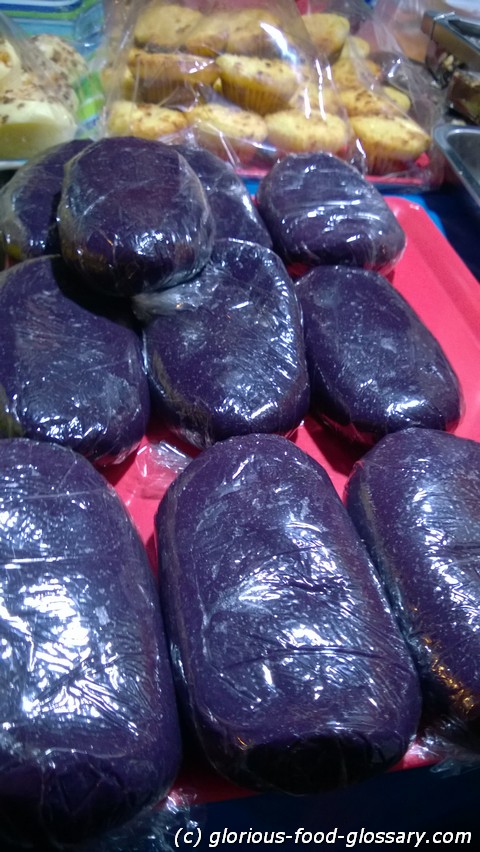Deutsch: Halaya / Español: Halaya / Português: Halaya / Français: Halaya / Italiano: Halaya
Halaya, in the food context, refers to a popular Filipino dessert known as Ube Halaya or Purple Yam Jam. It is a thick, sweet concoction made primarily from boiled and grated purple yam (ube), mixed with coconut milk, milk (often condensed and/or evaporated), and sugar. The mixture is cooked down until thickened into a dense, sticky paste, which can be eaten on its own or used as a filling or topping in various Filipino desserts and pastries.
Description
Ube Halaya is celebrated for its vibrant purple color, creamy texture, and sweet, earthy flavor. Ube, the key ingredient, is a type of yam native to the Philippines and other parts of Southeast Asia, known for its distinctive purple hue and sweet taste. Ube Halaya can be garnished with latik (fried coconut milk curd) or served with a sprinkling of coconut flakes, and it's commonly enjoyed during festive occasions and holidays, though it's also a beloved treat year-round.
Application Areas
Halaya is versatile and can be used in various culinary applications, including:
- Stand-alone Dessert: Often served at room temperature or chilled, cut into squares or molded shapes.
- Filling or Topping: Used in cakes, pastries, sweet buns, and as a topping for halo-halo, a famous Filipino shaved ice dessert.
- Spread: Can be spread on bread or crackers as a sweet, creamy treat.
Well-Known Examples
In addition to being enjoyed on its own, Ube Halaya is a crucial component in many Filipino desserts, such as:
- Ube Cake: A vibrant purple cake made with ube halaya in the batter, often layered with ube halaya filling.
- Ube Ice Cream: Ice cream flavored with ube halaya, known for its rich, creamy texture and unique taste.
- Ube Pandesal: A modern take on traditional Filipino bread rolls, filled with ube halaya.
Recipes
A basic recipe for making Ube Halaya involves:
-
Ingredients:
-
Preparation:
- In a large pan, melt the butter over medium heat. Add the grated ube and cook for a few minutes.
- Pour in the coconut milk, condensed milk, and sugar. Stir well to combine.
- Continue to cook the mixture over low heat, stirring constantly to prevent sticking, for about 30-45 minutes, or until the mixture thickens to a paste-like consistency.
- Once thickened, you can add vanilla extract for additional flavoring.
- Transfer the halaya to a greased dish, mold, or container and let it cool. Refrigerate until set.
- Serve chilled, garnished with latik or coconut flakes if desired.
Treatment and Risks
Making Ube Halaya is generally safe, but care should be taken when handling hot ingredients and during the lengthy stirring process to prevent burns. As a dessert high in sugar and fat, it should be consumed in moderation, especially by individuals monitoring their sugar intake or those with dietary restrictions.
Similar Terms or Synonyms
- Ube Jam
- Purple Yam Jam
Summary
Halaya, particularly Ube Halaya, is a quintessential Filipino dessert loved for its unique flavor, vibrant color, and versatility in various sweet applications. Whether enjoyed on its own, as a filling, or as a topping, ube halaya is a celebration of Filipino culinary heritage, bringing a taste of the Philippines to tables around the world.
--
Halaya refers to sweetened purple yam. Cooked or boiled yam is grated then cooked with Coconut milk (Gata) until sticky . Halaya is served as dessert and one of the ingredients of the famous dessert in the Philippines called Halo-Halo

Related Articles to the term 'Halaya' | |
| 'Bubur Cha Cha' | ■■■■■■■■■■ |
| Bubur Cha Cha refers to one of Malaysia\'s popular dessert which is cooked with yam, sweet potatos, bananas, . . . Read More | |
| 'Sorbete' | ■■■■■■■■■■ |
| Sorbete in the food context refers to a traditional type of Filipino ice cream, distinctively known for . . . Read More | |
| 'Kalihim (Pan de Regla)' | ■■■■■■■■■ |
| Kalihim (Pan de Regla): Kalihim refers to one of the breads found in local bakeshops in the Philippines . . . Read More | |
| 'Cendol' | ■■■■■■■■■ |
| Cendol is an Indonesian drink which is made with brown sugar, jackfruit, gelatin, coconut milk and the . . . Read More | |
| 'Donut' | ■■■■■■■■■ |
| Donut in the food context refers to a popular sweet, deep-fried . . . . . . Read More | |
| 'Malagkit' | ■■■■■■■■■ |
| Malagkit refers to glutinous or sticky rice in the context of Filipino cuisine. It is a type of rice . . . Read More | |
| 'Buco / Buko' | ■■■■■■■■■ |
| Buco / Buko: Buco also spelled as Buko is a Filipino word that refers to a young coconut with soft, thin . . . Read More | |
| 'Matamis na Bao' | ■■■■■■■■■ |
| Matamis na Bao also called Coconut Jam in English refers to a thick, sweet, syrupy stuff made from fresh . . . Read More | |
| 'Kamoteng Kahoy' | ■■■■■■■■ |
| Kamoteng Kahoy is a Filipino word for Cassava. It is also known as Yucca. In the Philippines, Kamoteng . . . Read More | |
| 'Pittu' | ■■■■■■■■ |
| Pittu refer to Sri Lanka\'s dish of cylinder rolls made of rice flour and grated coconut. Traditionally . . . Read More | |
